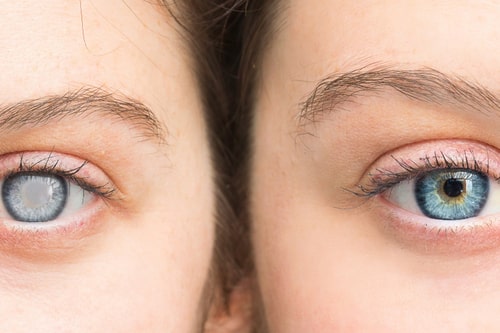If your vision has become blurry, there might be a fair chance you’re suffering from cataracts. Commonly found in adults 60 years or older, a cataract involves the clouding of the natural lens. If you have developed this condition, everything might seem like it’s being viewed through a frosty window. This could increase difficulty in going about your day or doing normal day-to-day tasks. From experiencing irritation in reading, working, or driving, Cataracts can cause serious health concerns and require immediate medical attention. It would be best to visit your nearest eye care center for further consultation.
Now, you might not notice it at first. Cataracts usually develop slowly, but once it affects your vision, it’s advisable to seek professional help. It starts developing when clumps of protein accumulate around the eye, preventing the transmission of a clear image from the eye to the retina. This cloudy vision sent from the eye lens is converted into signals sent to the optic nerve and later to the brain. Around 50 percent of older individuals all over the United States have this condition.
What are the Symptoms of Cataracts?
Usually formed slowly and gradually, cataracts may go unnoticed until they block light through your eyes, forming a blurry ring around anything you’re viewing. This blurry area might grow with time, deteriorating the quality of vision. The situation worsens if immediate medical attention isn’t given to it. Finding trouble in distinguishing color or color change are signs of this condition. When you find it extremely difficult to differentiate between shades of blue and purple or might find it hard to read your favorite book, you likely have developed Cataracts. Other symptoms include:
- Foggy vision
- Color blindness
- Nearsightedness
- Eye sensitivity (Especially from sharp light glares)
- Double vision
- Extreme irritation while wearing the lens.
A need to frequently change your eyeglasses or lenses can be another sign of cataracts; frequent headaches, sudden changes in vision, or sharp flashes of light might accompany these issues. If something like this happens, see an ophthalmologist and take a comprehensive eye care exam immediately.
What Causes Cataracts to Form?
Cataracts are quite common to develop with age as aging affects the tissue present in the eye lens. All the protein and fiber that make up the lens begin to break down eventually with time. It’s a natural process; there is nothing new about it. This breakdown of all the protein and fibers in the eye causes the vision to become hazy. In addition to aging, some inherited disorders that cause you to have weak eyesight from the early stages of your childhood might also increase the risks.
If you have undergone eye surgery or have other medical conditions such as diabetes, you can easily develop this disease over time. Excessive use of medication or steroids might also encourage this condition. Irrespective of the cause, early detection and immediate medical attention can save you from losing your vision.
How Does it Form?
Your eye lens is positioned behind your iris, focusing on the light passing through your eye to the retina, producing sharp images. This light membrane here functions more like a film in a camera. But as you age, this lens also starts to age like anything else. With time the lens of your eye may become flexible, thicker, and less transparent.
Once the cataract has developed, the clouding becomes denser and thicker than ever. This clouding eventually blocks the light passing through your lens, creating problems for the retina to form a sharp, clear image around your retina, which results in blurred vision. It can develop in both eyes but at a different rate. One eye may get affected more severely than the other, causing a significant difference in vision.
Types of Cataracts
There is no single type of cataract. Given below are some of the types that you might educate yourself on.
1. Nuclear Cataracts
In a nuclear cataract, your lens may develop a densely yellow color. After some time, as this slowly progresses, it may cause the yellowish lens of your eye to become brown. This may further lead to difficulty distinguishing between shades of color, causing color blindness and eye irritation.
2. Cortical Cataracts
A cortical cataract may be quite different from a nuclear cataract. Forming a whitish streak on the outer edge of the lens cortex, this wedge-shaped opacity extends over time and disrupts light flow from the center of the lens, resulting in poorly formed vision that is cloudy and hazy.
3. Congenital Cataracts
Congenital cataracts, as its name implies, are inherited, which some people might develop from childhood. Often associated with an infection, eye diseases, or genes, these cataracts don’t develop naturally. You are born with them or might face it as a side effect of some eye surgery you might have had in the past. Congenital cataracts may also form due to myotonic dystrophy, galactosemia, or rubella.
4. Posterior subcapsular cataracts.
This sort of cataract mainly affects the back of the eye lens. The back of the lens is situated directly in the path of light. A posterior subcapsular cataract leads to foggy vision while reading, or it might impact your night vision profoundly. It can progress faster than any other cataract there.
Prevention
If you experience any eye cataract symptoms mentioned above, it is advisable to seek professional help from a reliable eye care center. Moreover, if you suffer from health problems such as diabetes, you should strictly follow a diet plan as prescribed by your health advisor. Similarly, following a diet rich in nutrients helps maintain your overall eye health.
Wrap Up
It’s always advisable to schedule routine checkups with your eye care specialists, even if you have healthy vision. Your eye specialists can help detect severe eye diseases such as cataracts, glaucoma, and other severe conditions at an early stage. So, next time you visit, you pass by an eye clinic; make sure to schedule an appointment.

